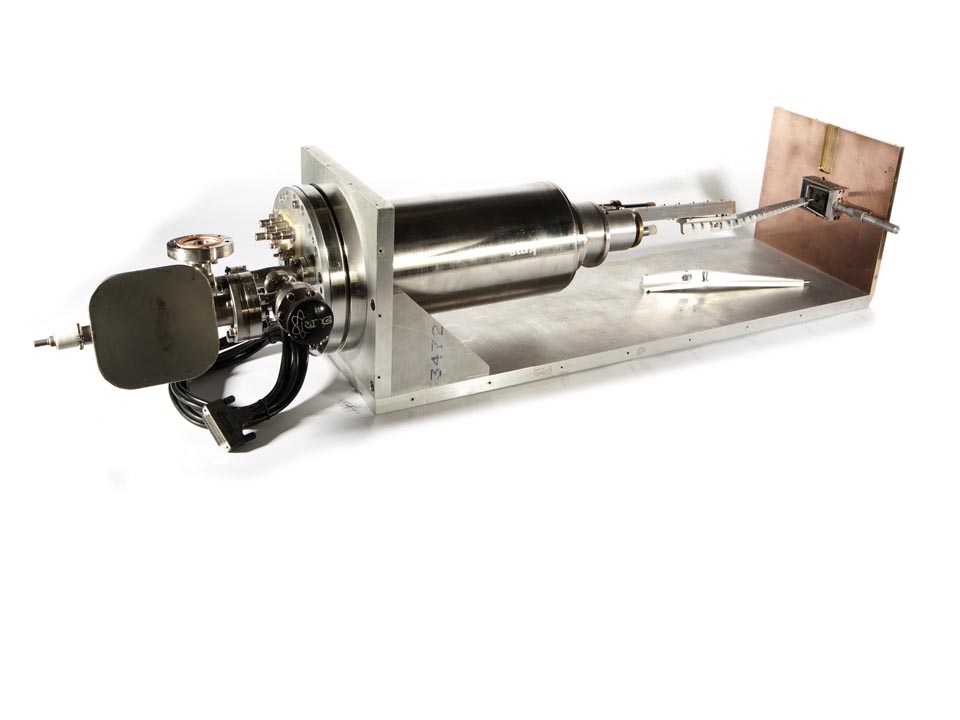High-Energy X-ray Continuum Bent Crystal Spectrometer

We no longer offer this product. If you want repair service or a custom modern equivalent, contact us.
This is a bent crystal spectrometer built by KMS Fusion for use on the Aurora inertial confinement fusion project. This instrument allows continuous recording of hard x-ray spectrum from 5 to 35 keV with an energy resolution E/∆E of 10-20 and provides two additional time resolved channels. Also included are an alignment/storage stand and two adjustable alignment pointers. The included CCD camera could easily be replaced with a modern instrument.
The instrument package for Aurora includes, in addition to the crystal spectrometer, two high-energy channels for time-resolved, energy-integrated continuum measurements in the 40-60 keV and 60-90 keV energy bands. The space requirements and the requirement that data on the crystal spectrometer be acquired electronically determined the design for this instrument. Of the many crystal configurations considered, only a de Broglie geometry was found to be sufficiently compact that the space constraints could be met while still achieving the required energy range.
The de Broglie geometry adapted for high-energy x rays is illustrated in Fig. 1 (see paper). Because Bragg angles are close to grazing incidence a relatively large energy range is diffracted by the convex-curved crystal in the forward direction. The diffracted spectrum is sufficiently compressed that it can be recorded with low-energy resolution with a single, compact position sensitive detector. By close coupling the detector to the crystals it is possible to obtain the low dispersion required for high sensitivity to continuum. A feature of this geometry is that due to the convex curvature of the crystal the source is demagnified.For a slitless spectrograph with resolution limited by source size this has the effect of reducing the dependence of energy resolution on source size. The main disadvantage of the de Broglie geometry at high energies is that Bragg angles are close to grazing incidence so that accurate placement of stops is critical to avoid direct beam shine through and prevent background.
A set of stops in the collimator assembly defines the optical axis to which the crystals are aligned. The crystals are adjustable in both height and angle. The detector housing has a 0.025 cm Be window that provides both a 4 ke V low-energy cutoff to block internal fluorescence and vacuum isolation for the MCP. The MCP housing is isolated from the target chamber vacuum and is pumped separately. Heavier shielding is used externally where appropriate.
The crystals chosen are PET 002 (2d = 8.75 Å) and LiF 200 (2d = 4.03 Å). Each crystal is 50 cm long and 1 cm wide, has a radius of curvature of 20.32 cm, and diffracts Bragg angles over the range of 5°-17°. Both crystals are mounted on aluminum substrates. Aluminum fluorescence from the exposed portion of the crystal mounts is blocked by the Be window on the detector housing. There is sufficient overlap in the energy range diffracted by each crystal that cross calibration is possible. These crystals were chosen because they have appropriate grating spacings for the dispersion required, minimal fluorescence, and have high mosaic integrated reflectivity at small Bragg angles.
A microchannel plate was chosen as the detector for the continuum spectrometer because it has adequate efficiency in this energy region, high gain, and provides two-dimensional readout. A 40:1 MCP with 12 µm channels is proximity focused to a P-20 phosphor-coated fiber optic (NA = 1, 12 µm fiber) for efficient coupling to a CCD. Spatial resolution is of the order of 50-100 µm and is more than adequate for the energy resolution required.
The two high-energy channels consist of collimated filtered scintillators for recording integrated continuum in the 40-60 keV and 60-90 keV energy intervals. K-edge filters define the energy band of interest while the scintillator material and thickness determine the high-energy cutoff. Cesium fluoride was chosen for its x-ray absorption efficiency and for the fact that its short decay time allows nanosecond time resolution, The scintillator is coupled to a 19 mm Hamamatsu R1450 photomultiplier tube which has good timing characteristics.
CONTACT
JOIN US
ABOUT US
